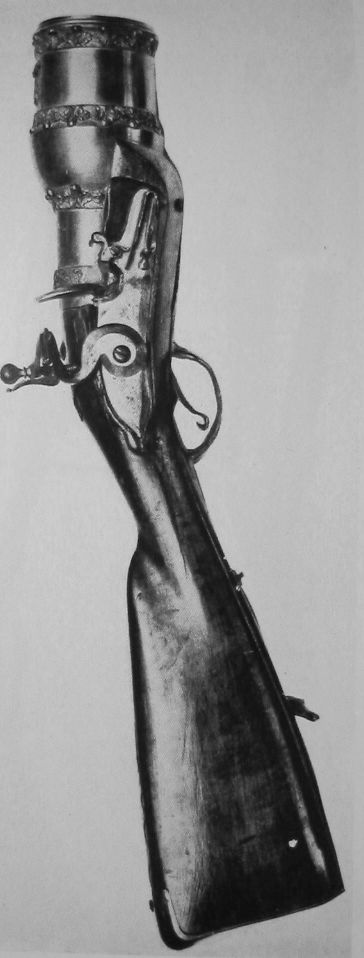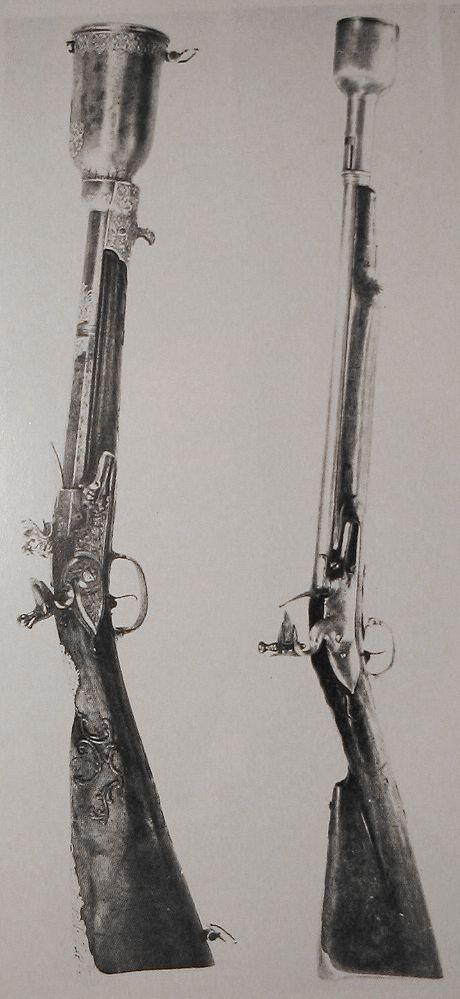-
Friends, our 2nd Amendment rights are always under attack and the NRA has been a constant for decades in helping fight that fight.
We have partnered with the NRA to offer you a discount on membership and Muzzleloading Forum gets a small percentage too of each membership, so you are supporting both the NRA and us.
Use this link to sign up please; https://membership.nra.org/recruiters/join/XR045103
You are using an out of date browser. It may not display this or other websites correctly.
You should upgrade or use an alternative browser.
You should upgrade or use an alternative browser.
Flintlock Mortor VERY COOL
- Thread starter blackbeard
- Start date

Help Support Muzzleloading Forum:
This site may earn a commission from merchant affiliate
links, including eBay, Amazon, and others.
Guest
Hi Arrowstorm
Actually they did they used them up untill the end of the rev war. They were common during the French and Indian war. As a matter of fact the first time I saw one was in the movie last of the Mohecans, the light Infantry had on at the fort siege. The marker carried one. I was interested then so I checked it out on the web (sorry long ago can't remember the site now). They said they were used as light support.
Best regards Loyalist Dawg :hatsoff:
PS Say does anyone know who makes em?
Actually they did they used them up untill the end of the rev war. They were common during the French and Indian war. As a matter of fact the first time I saw one was in the movie last of the Mohecans, the light Infantry had on at the fort siege. The marker carried one. I was interested then so I checked it out on the web (sorry long ago can't remember the site now). They said they were used as light support.
Best regards Loyalist Dawg :hatsoff:
PS Say does anyone know who makes em?
Does that Gotha grenade launcher have TWO locks (left hand barely visable, frizzen on right hand lock missing?)?
PS - why the excessive Roccoco manure on the two German flintlock mortars? That's an expensive embellishment for an issue weapon.
PS - why the excessive Roccoco manure on the two German flintlock mortars? That's an expensive embellishment for an issue weapon.
SKS_madman
40 Cal.
- Joined
- Jul 17, 2005
- Messages
- 128
- Reaction score
- 0
Story, They may have been issue guns but I bet they doubled as parage weapons, and I bet that you had to be an officer to be issued one as they were probably quite coveted.Does that Gotha grenade launcher have TWO locks (left hand barely visable, frizzen on right hand lock missing?)?
PS - why the excessive Roccoco manure on the two German flintlock mortars? That's an expensive embellishment for an issue weapon.
BTW, as asked before, anyone know where I can get a kit besides the rifle shoppe? Not touching that place with a ten foot pole.
I bet that you had to be an officer to be issued one as they were probably quite coveted.
Can't say I agree with that - officers had other duties, like leading troops, than performing as a grenadier. I could see where they were possibly for Guard or Household (parade) units, or perhaps prototypes for demonstration purposes. If you look at the last photo I posted, it's plain like a period-issue musket.
SKS_madman
40 Cal.
- Joined
- Jul 17, 2005
- Messages
- 128
- Reaction score
- 0
I see what you are saying, but my line of thinking was that, like a sniper (operating a barett .50 caliber) today, they got special training and an according rank so they were technichally officers. Though you are probably right.I bet that you had to be an officer to be issued one as they were probably quite coveted.
Can't say I agree with that - officers had other duties, like leading troops, than performing as a grenadier. I could see where they were possibly for Guard or Household (parade) units, or perhaps prototypes for demonstration purposes. If you look at the last photo I posted, it's plain like a period-issue musket.
Think of the job of that grenadier (usually the tallest of soldiers - at least in the British army). He has to light the fuse and then fire the mortor. If the gun mis-fires he's holding a hand-grenade at head level. Some got smart and reversed the grenade so that the fuse was lit upon firing . . . and was occasionally driven into the charge instantly. Again, an explosion at head level.
I don't think an officer would have stood within 20 yards of one of those babies. Probably issued to sappers who trenched up close to a besieged fort and lobbed mortors into them. A position too hot for a large set-piece mortor.
I don't think an officer would have stood within 20 yards of one of those babies. Probably issued to sappers who trenched up close to a besieged fort and lobbed mortors into them. A position too hot for a large set-piece mortor.
Think of the job of that grenadier (usually the tallest of soldiers - at least in the British army). He has to light the fuse and then fire the mortor. If the gun mis-fires he's holding a hand-grenade at head level. Some got smart and reversed the grenade so that the fuse was lit upon firing . . . and was occasionally driven into the charge instantly. Again, an explosion at head level.
I don't think an officer would have stood within 20 yards of one of those babies. Probably issued to sappers who trenched up close to a besieged fort and lobbed mortors into them. A position too hot for a large set-piece mortor.
My guess is that might have happened once or twice and then the officers instituted a drill to deal with it - like dumping the loosely (or not even) wadded grenade into a sump.
Replacing those brass barrels would have been expensive, ya know. ::
I remember looking at the following when the auction was about to happen. Unfortunatley, the link to the large resolution photo is toast.

French Grenade-Launcher/Hand-Mortar, c. 1754 Length: 24
SKS_madman
40 Cal.
- Joined
- Jul 17, 2005
- Messages
- 128
- Reaction score
- 0
Stumpy, I I was of the impression that they fired with fuse out and the unburnt powder from the launching ignited ther fuse as it left the barrel? I mean if they did it with grenade-in, it would definetly push the grenade in and make the greandier into a pile of mush. :nono:
I haden't heard that, but it may be the case.
Closest I ever came to one was a "cup" which attached like a bayonet that Kit Ravenshear showed me which he had fabricated to fit a Bess. He used it to launch tennis balls at the "enemy" camp at reenactments during lulls. That is, until the day one lit a tent on fire. :shocking:
Closest I ever came to one was a "cup" which attached like a bayonet that Kit Ravenshear showed me which he had fabricated to fit a Bess. He used it to launch tennis balls at the "enemy" camp at reenactments during lulls. That is, until the day one lit a tent on fire. :shocking:
SKS_madman
40 Cal.
- Joined
- Jul 17, 2005
- Messages
- 128
- Reaction score
- 0
the bolded ones were meant to say fuse, not grenade. :redface: I have no clue what kinda retarded moment made me type it like that.Stumpy, I I was of the impression that they fired with fuse out and the unburnt powder from the launching ignited ther fuse as it left the barrel? I mean if they did it with grenade-in, it would definetly push the grenade in and make the greandier into a pile of mush. :nono:
I don't recall anything on the barrel but the bayonet lug; but this was 20 years ago. I think the socket below the cup was stepped inside so the muzzle supported the recoil. I doubt his would have handled a "true" grenade. The barrel itself would be suspect in lobbing a two or three pound pomegranate grenade.
I have seen things like Kit had that are used to heave messenger lines from ship-to-ship or across water when attached to a smoothbore with a wood ball or monkey's-fist on the end of a light line.
I have seen things like Kit had that are used to heave messenger lines from ship-to-ship or across water when attached to a smoothbore with a wood ball or monkey's-fist on the end of a light line.
Think of the job of that grenadier (usually the tallest of soldiers - at least in the British army). He has to light the fuse and then fire the mortor. If the gun mis-fires he's holding a hand-grenade at head level. Some got smart and reversed the grenade so that the fuse was lit upon firing . . . and was occasionally driven into the charge instantly. Again, an explosion at head level.
I don't think an officer would have stood within 20 yards of one of those babies. Probably issued to sappers who trenched up close to a besieged fort and lobbed mortors into them. A position too hot for a large set-piece mortor.
these launchers seem to be a bit of a rarity precisely because of the fuse problem, which wasn't solved reliably until WW1
The grenadiers were part of a craze, like the zouave craze in the ACW. They were the tallest strongest and best fed because that had to be to carry 6 x 2 1/2 inch gendaes in addition to all the normal gear, and also to be able to throw said grenades effectively (50 feet?).
William III, Anne, and George I all had to repeatedly issue orders for normal regiments not to adopt grenadier caps because they were so fashionable with the military. Eventually most regiments got their elite company into grenadier gear, even though many had never handled grenades in their lives!
Most of the troops who used grenades were indeed sappers and fortress garrison troops...
Similar threads
- Replies
- 6
- Views
- 871








